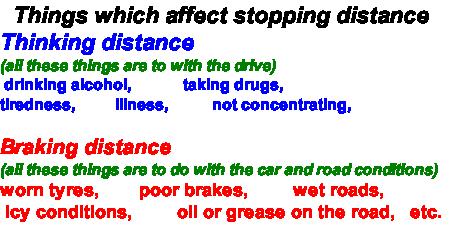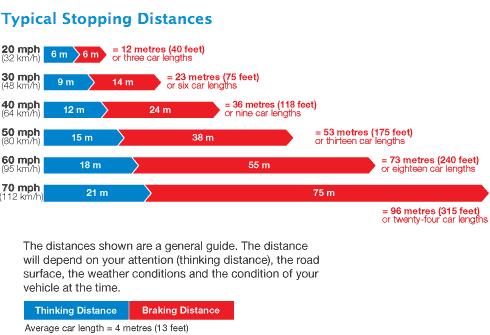Everybody has to learn about stopping distances before they take their drivers test to get their license?
Stopping distances are a mix of two things:
• The thinking distance – the length of road travelled from when you see something which will need you to stop and in reality hitting the brake pedal
• The braking distance – the amount of road travelled from first using the brakes to actually coming to a stop
Both of these things can be influenced by a variety of outside influences and circumstances, all of which have to be taken into consideration when calculating the safest stopping distance and for that reason the space you must leave in between your vehicle and also the vehicle in front of you.
Thinking Distance
Many factors can affect this, not just the speed at which the vehicle is travelling.
• Tiredness / alertness
• Alcohol
• Drugs – illegal and legal drugs can have an influence
• Age – older drivers may have slower reactions which implies a longer thinking distance is needed
• Distractions – like switching channels on the radio or fiddling with a mobile phone
• Impaired vision – this can increase the reaction distance needed
Braking Distance
This can also be influenced by many different factors, as well naturally as the speed at which the auto is travelling.
• The body weight of the car
• The condition of the tires – the braking distance will be increased when tires are worn, particularly in wet weather
• The brakes – the condition of the brakes obviously includes a big impact on the amount of stopping distance needed. Worn brake discs and pads will both mean that the vehicle will need longer to stop
• Road conditions – it can always take longer to stop once the roads are icy or wet . . . so remember to take this under consideration when driving
• Road surface – the condition of the surface of the road and the grade of the road maintenance can also affect stopping distances. If a road is covered with gravel, mud or dirt the stopping distance will likely be increased
So how far does it get you to stop, what distance should you really allow when driving down the road at different speeds?
Here’s a listing to give you an idea, notice just how much the stopping distances increase as you drive faster, it can be quite surprising. If any of these factors are to be considered, you should also remember that these distances are calculated for driving along in the well maintained car in good weather and road conditions so need to be increased.
20 mph – The thinking distance when driving at 20 mph is 20 feet, the braking distance is about the same which supplies a grand total of 40 feet stopping distance.
30 mph – When driving at 30 mph you will need 30 feet worth of thinking distance but 45 feet of braking distance, a sharp rise to 75 feet stopping distance.
50 mph – The faster you drive the better the stopping distances rise. When travelling at 50 mph you need 50 feet of thinking distance yet 125 feet of braking distance . . . an overall of 175 feet.
70 mph – Although the thinking distance remains pretty constant (you will need 70 feet of thinking distance at 70 mph) the braking distance increases to your whopping 245 feet . . . 315 feet as a whole.
You will still need to heed the stopping distances, though it is essential which you give yourself the appropriate amount of stopping distance towards the speed at which you are travelling. At Nissan Montclair they’ve got a bit of great cars with superb brakes. Browse the choices at Metro Nissan Redlands.


